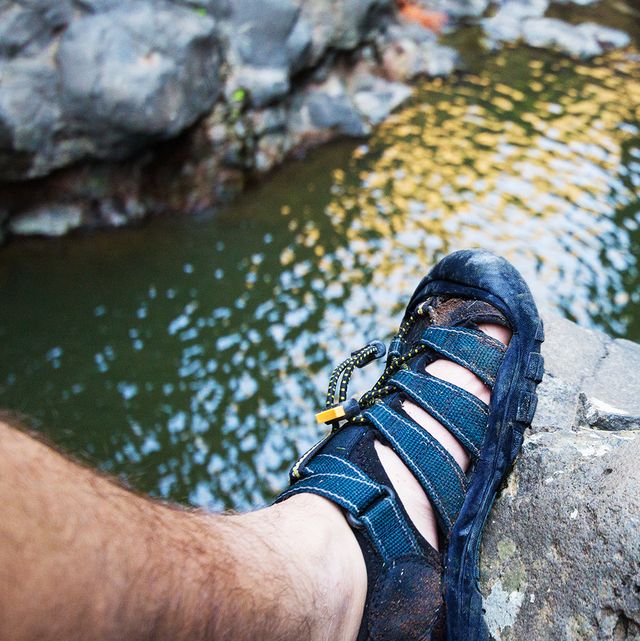
You may be interested in barefoot fitness if you are looking for an innovative way to improve your health and fitness. This alternative to regular gym training offers some benefits as well as disadvantages. This article will discuss the potential drawbacks and precautions. Once you have a better understanding of this new way of exercising, you can go on to begin your training program barefoot. You should start slow, using light weights and following proper movement patterns. Then, you can work your way up.
Benefits
Barefoot exercise has many benefits. Barefoot allows for more sensory feedback to our nervous system. This is vital for the proper functioning the body's stabilizing muscle. It can also improve balance and posture. Barefoot exercise has many other benefits than convenience. These are just three. 1. More effective results. Using your feet as leverage is beneficial in preventing injury.
Exercise barefoot has another benefit: it improves balance and body awareness. Peripheral nerves in the feet send signals to brain. If these nerves are damaged, your body might have difficulty controlling its muscles or staying straight. Running barefoot can improve balance and proprioception. You will feel more sensation between your toes. This prevents injury and increases your body's ability adapt to stress.

Drawbacks
You might wonder what the downsides are to going barefoot. The truth is that there are some drawbacks to barefoot training, too. You might feel uncomfortable when you first get used to the idea of using barefoot in commercial gyms, or for bounding. Lifting or performing other activities that require shoes may cause discomfort. But the benefits outweigh all the disadvantages.
Barefoot exercise has one drawback. It can cause injury to the second metatarsal which is particularly vulnerable. If you've been wearing shoes all your life, you might want to take a step back and try barefoot yoga or other activities gradually. To prevent sprains and fractures, you may also consider purchasing barefoot tape or stick on soles. Keep in mind, however, that not all gyms require you to wear shoes.
Precautions
Barefoot running can be enjoyable and healthy. However you must take precautions to avoid injury. Barefoot training can help improve your balance and posture as well as stability. Barefoot exercises can prove dangerous if they are stepped on by a sharp object or lifted heavy objects. If you're not sure whether going shoeless is right for you, check with a physical therapist, podiatrist, or running shoe specialist first.
If you plan on going barefoot for your workout, make sure to wear shoes while adding weights to your routine. The same goes for unracking the weight you've already added. A safety collar should be worn to protect your feet and prevent weight plates from sliding. If you are unsure whether you should go naked, you can begin with light activities like walking around the neighborhood.

How to go barefoot
Although most fitness experts will agree that barefoot running is a good idea it can also be dangerous. It all depends on your type of training. A shoe that mimics barefoot running is better than one with a high-heeled sole if you are going to run a marathon. Also, consider how comfortable you will feel going barefoot.
The number one advantage of working out barefoot is that it boosts proprioception, which helps your body understand where it is in space. It is essential to have good coordination, balance, stability, and the ability to see where you are in space. Barefoot exercises will help you be more aware and in control of your body's movements. You'll feel stronger, healthier, and more alert. Two examples of exercises that enhance proprioception are paddleboarding and barefoot swimming.
FAQ
Can I eat while I exercise?
Yes. You can eat what you like while you work out. Watermelon, grapes (or carrots or celery), watermelon, grapes, apples, bananas or apples are all low-calorie snacks. These foods are rich in nutrients that will help you work out better.
How can exercise and nutrition help you live a healthier life?
Exercise can help you lose weight, gain muscle mass and reduce stress. Nutrition is critical for energy and mood. If you want to live longer, eat less meat, drink alcohol moderately, avoid smoking, and do regular physical activity.
Do I gain weight from exercising?
Not at all. You can even maintain your weight by exercising. Regular exercise will help you build muscle and boost your metabolism. This will allow you to burn more calories every day. This means your body won’t store as much weight.
Why is it important that you get enough sleep?
Sleep is essential for maintaining a healthy lifestyle. Sleep is essential for your body to recover from daily stressors and repair itself. A good night's sleep is essential for optimal functioning throughout the day.
What does Exercise do for your Body?
Exercise can help you lose weight, increase muscle mass, improve energy levels, reduce stress and improve your sleep quality. Exercise can improve mood, self-esteem and productivity as well as reduce the risk of developing heart disease.
How can I start with fitness?
Start small. You can start by taking 10 minutes each week to walk around the block. This will show you how to move and give your muscles the time to adjust. After you have mastered this basic form of exercise, you can add more steps to your daily schedule.
What is the importance and benefits of good nutrition for your health?
We need to eat well for our health and wellbeing. A healthy diet includes fruits, vegetables, whole grains, lean protein, and dairy. Good nutrition is key to good overall health.
Statistics
- Physical activity confers the following maternal and fetal health benefits: a decreased risk of pre-eclampsia, gestational hypertension, gestational diabetes (for example, 30% reduction in risk) (who.int)
- An estimated 110,000 deaths per year could be prevented (cdc.gov)
- In high-income countries, 26% of men and 35% of women were insufficiently physically active, as compared to 12% of men and 24% of women in low-income countries. (who.int)
- Globally, 81% of adolescents aged 11-17 years were insufficiently physically active in 2016. (who.int)
External Links
How To
How to Burn Belly Fats Faster
Belly Fat is usually seen as a problem when we want to lose weight. However, Belly Fat can be beneficial if you really think about it. It is the fat in your stomach that protects your organs. Let's find out how to lose belly fat quickly.
Lack of exercise and stress are the main reasons we store body fat. The cortisol hormone stimulates stress which makes us hungry. Cortisol increases insulin levels in our blood. The insulin stores the excess calories as fat. A lack of sleep leads to adrenaline being released into the system which causes an increased appetite. These extra calories are broken down through exercise.
There are many different ways to reduce bellyfat. You can choose to try any of these options, depending on your budget. These tips will help you quickly get rid of belly fat.
-
Try to eat less food. You should eat smaller meals throughout the day than you would if you ate three big meals. This way, you'll consume fewer calories overall.
-
Drink lots of water. Water helps flush out toxins from the body and keeps you hydrated. Drinking water before meals will help you feel fuller for longer, so you don't overeat.
-
Avoid snack foods that are unhealthy. If you're looking for quick fixes, snack foods like chips, cookies, candies, etc. These tempting snacks might look appealing. These fattening treats are best avoided as they have too many empty calories and sugar. Instead, opt for healthy alternatives such as fruits, vegetables and whole grains.
-
Strength training should be done at least three times per week. Strength training builds muscle mass and burns more calories when you're not working out. Strength training strengthens bones, muscles and ligaments. It can also improve the heart, lungs, joints, and other body systems.
-
Walking or stretching is a good habit to do regularly. Stretching is a great way to increase flexibility and mobility. This helps reduce back pain. Walking is a great way of burning calories, especially when you do it for just 30 minutes.
-
Reduce alcohol intake. Reduce alcohol intake. Alcohol is a waste of calories and has no nutritional value.
-
Reduce your weight gradually. First, determine your current weight. Add 5%-10% of your total bodyweight to calculate your ideal size. Once you have calculated your target body weight, you can begin to cut calories by 500-1000 calories every day until your goal is reached.
-
Avoid processed foods. These foods are high-in salt, sugar, as well as preservatives. These processed foods are often convenient, but they lack enough nutrients for good health.
-
Don't skip breakfast! Eating breakfast improves concentration, memory, and energy level. Protein (like eggs), fiber and complex carbohydrates (like oatmeal) should be included in breakfast.
-
Have regular bowel movements. Bloating and gas can be caused by irregular bowel movements and constipation. To prevent this, drink plenty of water and increase fiber intake.